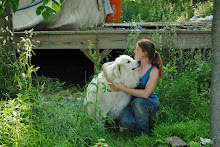According to some of our neighbors from across the street, who come out to volunteer every week or so, the hills around here are rife with bears. Whether day or night, so they say, they can't walk past their dumpster without interrupting some nosy black bear's snack. News of our neighbors' furry visitors came as something of a shock to us, caregivers to 5 large, yummy cows, 8 scrumptious pigs, and 80-odd small but juicy chickens (not to mention several steaming piles of composting food scraps). As I am generally the last to make the trek to my cabin (inevitably well after dark and without anything more threatening than an oversize fleece), this news kicked my imagination into overdrive.
For whatever reason, however, the bears seem unwilling to cross the road. Perhaps they recognize that our side of the valley is coyote territory, and the bears dare not trespass. I've grown accustomed to the sound of coyotes howling as I drift off to sleep, and I actually rather like it. Coyotes know better than to bother our cows, our pigs are safely stowed in the barn, and the chickens so far seem secure within the electrified netting that surrounds their coop. But. The coyotes do seem to be getting bolder. We've noticed tracks in the back of our main greens and roots field, and several days ago Don saw one in the early morning just beyond the fence in the river field. Now Katie has begun reporting sightings as well, a lone canine, trotting through the garlic and sniffing around as though he owns the place.
As we all thought that coyotes travel in packs, the current theory to explain this particular pup is that he is perhaps vegetarian, and therefore a pariah among his kind. Whatever the truth, he had better remain a vegetarian, at least as far as Caretaker Farm is concerned, lest we "take care" of him.
Then again, though, if those pesky groundhogs near our cabins were to "disappear," we certainly wouldn't ask any questions.
For whatever reason, however, the bears seem unwilling to cross the road. Perhaps they recognize that our side of the valley is coyote territory, and the bears dare not trespass. I've grown accustomed to the sound of coyotes howling as I drift off to sleep, and I actually rather like it. Coyotes know better than to bother our cows, our pigs are safely stowed in the barn, and the chickens so far seem secure within the electrified netting that surrounds their coop. But. The coyotes do seem to be getting bolder. We've noticed tracks in the back of our main greens and roots field, and several days ago Don saw one in the early morning just beyond the fence in the river field. Now Katie has begun reporting sightings as well, a lone canine, trotting through the garlic and sniffing around as though he owns the place.
As we all thought that coyotes travel in packs, the current theory to explain this particular pup is that he is perhaps vegetarian, and therefore a pariah among his kind. Whatever the truth, he had better remain a vegetarian, at least as far as Caretaker Farm is concerned, lest we "take care" of him.
Then again, though, if those pesky groundhogs near our cabins were to "disappear," we certainly wouldn't ask any questions.









